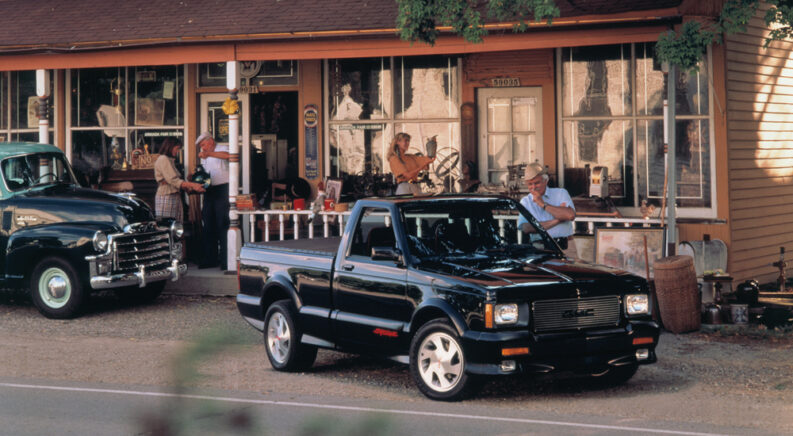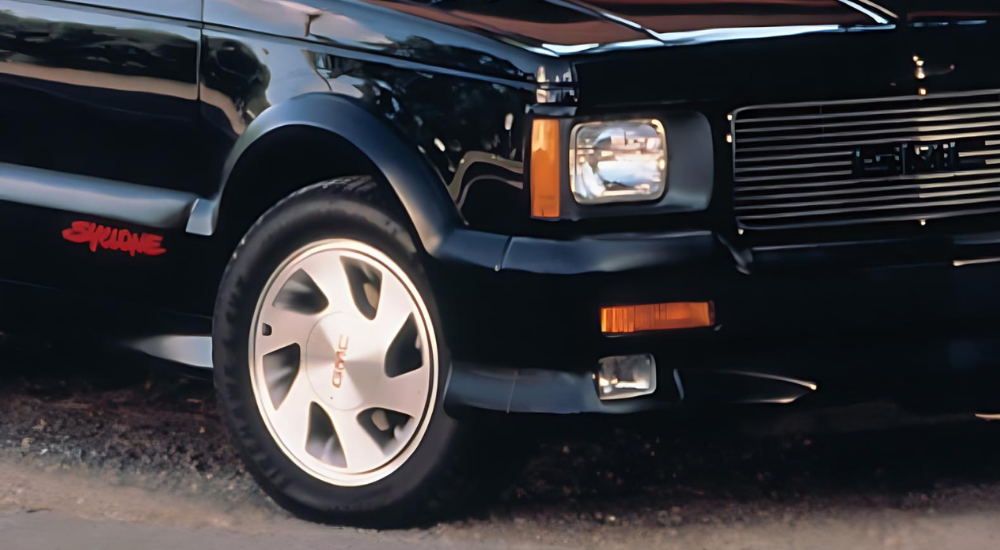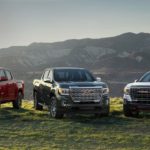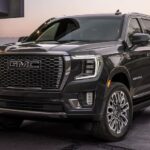What were you doing in 1991? Arnold Schwarzenegger coined “Hasta la vista, baby,” and a young Macaulay Culkin taught six-year-olds like me what to do when left home alone during Christmas. Friday nights were planned around television lineups featuring a young, suspenders-wearing Urkel, a home improvement show with grunts demanding “more power,” and a fresh prince that took Bel Air by storm. But what does any of this have to do with used trucks for sale?
The 1990s saw significant advancements across the automotive industry, but few were as impressive as the GMC Syclone. As a high-performance truck, the Syclone was legions ahead of its time, making history as the fastest production truck of 1991. It’s a truck that beat a Ferrari and set the stage for the modern powerhouses we know today.
Toying With an Idea: Let’s Build a Super Truck
As one of America’s “Big Three” automakers, General Motors has always looked for ways to shock the industry with next-level performance and ingenuity. In the late 1980s, the automaker started toying with the idea of a high-performance truck, a paradox in a realm ruled by muscle cars. How could a truck be raceworthy?
The outlandishness of the idea made it perfect, and General Motors gave engineers the green light on the project. The team took the 3.8L turbocharged V6 from the 1987 Buick Grand National and put it under the bulging hood of a redesigned Chevy S10. While Chevrolet wasn’t impressed enough to add the concept to its future lineup, GMC readily took the bait and introduced the prototype at the 1989 Chicago Auto Show on an S15 platform. With positive feedback and next-level anticipation, GMC engineers set out to bring the concept to life for Americans intrigued by the unthinkable.
The Perfect Heartbeat
GMC quickly discovered that using the Grand National’s turbocharged V6 engine was far too expensive, with production costs threatening the project before it ever got off the ground. The engineers ditched the Grand National’s heartbeat, turning to the S15’s turbocharged 4.3L V6 for inspiration. The 4.3L V6 had a solid foundation, producing 160 hp and 230 lb-ft of torque. The output was enough for any ordinary S15 but not for the powerhouse GMC envisioned.
GMC made vast improvements to the engine, borrowing the Mitsubishi TD06-17C turbocharger and adding a Garrett water-to-air intercooler and the bigger, 48-mm twin-bore throttle body from Chevrolet’s small-block 5.7L V8 that powered the Corvette. With a multi-point fuel injection system, redesigned intake and exhaust manifolds, and lower-compression hypereutectic pistons, the high-performance V6 added 120 horsepower to its wheelhouse. Paired with a quick-shifting Hydramatic four-speed automatic with overdrive transmission, it pushed the Syclone’s heartbeat to 280 hp and 350 lb-ft of torque.
The Syclone’s turbocharged heartbeat provides plenty of power. Yet, there’s the question of how that output is distributed and gives the Syclone its super truck status. Even though the super truck concept was new in the 1990s, GMC engineers recognized their work was far from over.
The team made widespread updates to the S15, adding a limited-slip differential at the rear, a center differential, and a BorgWarner all-wheel drive transfer case with viscous coupling. The all-wheel drive system is pivotal to the Syclone’s performance because it heightens traction and control under hard acceleration by sending 65% of the engine’s torque to the rear wheels and 35% to the front wheels. The sport-tuned suspension improved the Syclone’s handling, also lowering its ride height. GMC also introduced the first-ever application of anti-lock brakes on a production truck, guaranteeing the Syclone’s stopping power.
The Official Debut: Not Your Average S15-Turned Sonoma
GMC reintroduced the S15 as the Sonoma in 1991, but little attention was given to the name change. All eyes were on the Sylcone, GMC’s newest powerhouse that promised a launch from 0 to 60 mph in 4.3 seconds, making it faster than the 1991 Corvette and, as the world would soon learn, even a Ferrari. The Syclone even looked the part of a super truck, with its blacked-out exterior and lower stance making it vastly different from the ordinary Sonoma.
GMC practically put the Syclone in stealth mode, blacking out its grille, bumpers, and cladding. The lowered suspension was part of the Syclone’s body kit that reduced drag and added a deep front bumper with integrated fog lights and side skirts, a design ahead of its time in the 1990s. Red Syclone emblems on the doors provided the finishing touch to the exterior.
Inside, the Syclone mirrored the Sonoma’s configuration and layout, with modest differences that reflected its penchant for performance and pure thrills behind the wheel. GMC differentiated the Syclone by adding red-accented gauges and red piping along the cloth-upholstered bucket seats. Beyond this, the Syclone was an unsuspecting powerhouse fitted with an air conditioner, AM/FM radio, cruise control, power windows, and power doors. It could even tow up to 2,000 lbs despite a modest 500-lb payload. GMC touted the Syclone as a super truck toeing the line between excitement and practicality.
Outpacing a Ferrari: The Iconic Quarter-Mile Race to the Finish Line
The 1990s was an era fueled by hype, from pop culture influences and the emerging grunge scene to new technologies. The Syclone was part of this hype, but there was still the question of whether it was legitimate. Did the Syclone have the heart of a warrior like GMC promised? Could it actually launch from 0 to 60 mph in under five seconds? It all seemed impossible.
Car and Driver stopped the debate around the Syclone’s hype and put the super truck to the test in a street race against a Ferrari 348t with a $122,000 price tag and a mid-engine V8. The quarter-mile race spanned 1,320 ft with a single pass to determine the winner. The odds were unsurprisingly in the Ferrari’s favor, but the Syclone proved the importance of never discounting an underdog.
The 348t launched off the starting line and gained a brief lead before the Syclone showcased its prowess. Thanks to its all-wheel drive system offering full-boost torque at all four wheels and less weight at the truck’s rear, the Syclone lunged off the starting line without hesitation. The jolt was instantaneous, with minimal wheel slippage that put the Ferrari in the rearview mirror. The Syclone crossed the quarter-mile finish line ahead of its rival, sealing its fate as a provocative and unsuspecting super truck destined to make history.
Exclusivity: It’s Part of the Appeal
GMC wasn’t sure how the world would respond to the Syclone and recognized the super truck’s niche appeal. Because of this, GMC limited production to 2,995 units in 1991, with the Syclone priced at $25,970. No, that’s not a misprint. GMC touted the Syclone’s return in 1992, but the truck never made it back into production.
Today, the Syclone’s exclusivity and legendary history of beating a Ferrari make it one of the most sought-after collector’s items in the world. It’s also a testament to GMC’s ingenuity and forward-thinking in shaping the future of the truck segment. The Syclone introduced a new era of performance in an unsuspecting segment that, for decades, was defined by capable workhorses destined solely for hauling cargo and towing trailers. GMC helped shift that perspective, with the Sylcone offering plenty of practicality but an even greater penchant for speed. We see that balance across the ever-evolving truck segment, making the Syclone’s influence and allure undeniable and a cornerstone of the modern powerhouses that grace American roads today.





